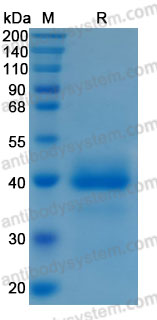Catalog No.
AMC27901
Biological activity
Measured by its ability to cleave the fluorogenic peptide substrate Z-LR-AMC. The specific activity is >2,000 pmol/min/µg, as measured under the described conditions.
Expression system
Mammalian Cells
Species
Mus musculus (Mouse)
Protein length
His18-Phe339
Nature
Recombinant
Endotoxin level
<0.1 EU/μg of the protein by the LAL method.
Purity
>90% as determined by SDS-PAGE.
Accession
P10605
Applications
Bioactivity, ELISA, Immunogen, SDS-PAGE, WB
Form
Lyophilized
Storage buffer
Lyophilized from a solution in PBS pH 7.4, 5% Trehalose, 5% Mannitol.
Reconstitution
Reconstitute in sterile water for a stock solution. A copy of datasheet will be provided with the products, please refer to it for details.
Shipping
In general, proteins are provided as lyophilized powder/frozen liquid. They are shipped out with dry ice/blue ice unless customers require otherwise.
Stability and Storage
Use a manual defrost freezer and avoid repeated freeze thaw cycles. Store at 2 to 8°C for one week. Store at -20 to -80°C for twelve months from the date of receipt.
Alternative Names
APP secretase, CPSB, Cathepsin B, Cathepsin B1, CTSB, APPS,
Unveiling the Role of Cathepsins on Lung Function in Chronic Obstructive Pulmonary Disease: A Mendelian Randomization Analysis., PMID:40502432
Causal effects and plasma protein mediators between type 2 diabetes and erectile dysfunction: a Mendelian randomization study., PMID:40463815
Cathepsin B-dependent glycolysis contributes to reduced renal uric acid excretion in hyperuricemia., PMID:40457023
Whey protein hydrolysate alleviated acetaminophen-induced hepatocyte pyroptosis by activating mitophagy., PMID:40451585
ATP7A Maintains Bactericidal Function of Neutrophils and Macrophages via Regulating the Formation and Activation of Phagolysosomes., PMID:40448432
Identification, Expression Profiling, Microbial Binding, and Agglutination Analyses of Two Cathepsin B Genes in Black Rockfish (Sebastes schlegelii)., PMID:40422803
Identification of TRPV1-Inhibitory Peptides from Takifugu fasciatus Skin Hydrolysate and Their Skin-Soothing Mechanisms., PMID:40422786
Peptidomimetic Phenoxymethyl Ketone Warheads as Potent Dual-Mode Inhibitors against SARS-CoV-2 Mpro and Cathepsin., PMID:40415551
The lysosome-associated SLAMF7 inhibits the development of ovarian cancer by promoting lysosomal damage., PMID:40414453
The mycotoxin Beauvericin is an uncompetitive inhibitor of Cathepsin B., PMID:40411408
TFE3-mediated lysosomal biogenesis and homeostasis alleviates arsenic-induced lysosomal and immune dysfunction in macrophages., PMID:40409189
Inhibiting cathepsin B alleviates acute lung injury caused by sepsis through suppression of pyroptosis in lung epithelial cells., PMID:40394663
ETS1 promotes the expression of Ctsb and Mmp13 during the differentiation of septoclasts from pericytes., PMID:40387924
Combined effects and potential mechanisms of volatile organic compounds on thyroid disease in the US population: An integrated epidemiological and computational toxicology study., PMID:40378728
NF-kappa-B inhibitor alpha mediates cancer stemness characteristics in oral squamous cell carcinoma by interacting with cathepsin B., PMID:40316102
Revealing the Oxidative Stress-Related Molecular Characteristics and Potential Therapeutic Targets of Schizophrenia through Integrated Gene Expression Data Analysis., PMID:40214957
Neutrophil-derived serine proteases induce FOXA2-mediated autophagy dysfunction and exacerbate colitis-associated carcinogenesis via protease activated receptor 2., PMID:40205686
Cathepsin B promotes optic nerve axonal regeneration., PMID:40177832
Salmonella Typhi serine threonine kinase T4519 induces lysosomal membrane permeabilization by manipulating Toll-like receptor 2-Cystatin B-Cathepsin B-NF-κB-reactive oxygen species pathway and promotes survival within human macrophages., PMID:40168426
Identification and expression analysis of cathepsin B genes in Myzus persicae (Hemiptera: Aphididae) and their response to environmental stresses., PMID:40162632
Vanillic acid inhibits TGF-β type I receptor to protect bone marrow mesenchymal stem cells from radiation-induced bystander effects., PMID:40104744
Function of lamp2 Gene Response to Vibrio vulnificus Infection and LPS Stimulation in the Half-Smooth Tongue Sole (Cynoglossus semilaevis)., PMID:40076623
Analysis of cellular senescence-related genes in calcified aortic valve disease and the potential therapeutic role of β-Carotene., PMID:40063555
The SGLT2 inhibitor dapagliflozin suppresses endothelial cell pyroptosis mediated by the NF-κB/NLRP3 pathway through downregulation of CTSB., PMID:40058708
Menin maintains lysosomal and mitochondrial homeostasis through epigenetic mechanisms in lung cancer., PMID:40057469
Stimuli-responsive polymer-dasatinib prodrug to reprogram cancer-associated fibroblasts for boosted immunotherapy., PMID:40054628
Calcium modulating ligand confers risk for Parkinson's disease and impacts lysosomes., PMID:40053464
Unraveling the Role of Cathepsin B Variants in Polycystic Ovary Syndrome: Insights from a Case-Control Study and Computational Analyses., PMID:40044993
The therapeutic potential of (R)-carvedilol in Huntington's disease through enhancement of autophagy-lysosomal pathway via GSK-3β inhibition., PMID:40011132
In silico evaluation of missense SNPs in cancer-associated Cystatin A protein and their potential to disrupt Cathepsin B interaction., PMID:40007784
A Dual-Targeted Molecule for Disease-Activatable Proteolysis Targeting Chimeras and Targeted Radionuclide Therapy of Cancer., PMID:39989465
A bacterial effector manipulates host lysosomal protease activity-dependent plasticity in cell death modalities to facilitate infection., PMID:39964716
Biochemical analyses of cystatin-C dimers and cathepsin-B reveals a trypsin-driven feedback mechanism in acute pancreatitis., PMID:39962054
The molecular mechanism by which CTSB degrades FPN to disrupt macrophage iron homeostasis and promote the progression of atherosclerosis., PMID:39960586
Cathepsin B prevents cell death by fragmentation and destruction of pathological amyloid fibrils., PMID:39955315
Association Analysis of the Circulating Proteome With Sarcopenia-Related Traits Reveals Potential Drug Targets for Sarcopenia., PMID:39949133
Analysis and validation of programmed cell death genes associated with spinal cord injury progression based on bioinformatics and machine learning., PMID:39929099
Identifying novel drug targets for calcific aortic valve disease through Mendelian randomization., PMID:39922081
Development of ASGR-Mediated Hepatocyte-Targeting Cytotoxic Drug Conjugates with CTSB-Cleavable Linkers Incorporating Succinimide and Succinic Acid Monoamide., PMID:39918134
Fraxinellone-mediated targeting of cathepsin B leakage from lysosomes induces ferroptosis in fibroblasts to inhibit hypertrophic scar formation., PMID:39905520
Elucidating the causal associations and mechanisms between circulating immune cells and idiopathic pulmonary fibrosis: new insights from Mendelian randomization and transcriptomics., PMID:39896814
Muscle Cathepsin B treatment improves behavioral and neurogenic deficits in a mouse model of Alzheimer's Disease., PMID:39896474
Smad4 deficiency ameliorates the progressive corneal stroma thinning caused by the loss of Tbr1., PMID:39894408
Limiting cap-dependent translation increases 20S proteasomal degradation and protects the proteomic integrity in autophagy-deficient skeletal muscle., PMID:39878121
The role of GSK3β signaling mediated lysosomal biosynthesis dysregulation in fluoride-induced neurological impairment., PMID:39842563
A network-based systems genetics framework identifies pathobiology and drug repurposing in Parkinson's disease., PMID:39837893
Identification of critical endoplasmic reticulum stress-related genes in advanced atherosclerotic plaque., PMID:39814777
NR1D1 Inhibition Enhances Autophagy and Mitophagy in Alzheimer's Disease Models., PMID:39812544
hCeO2@CA-074Me Nanoparticles Alleviate Inflammation and Improve Osteogenic Microenvironment by Regulating the CTSB-NLRP3 Signaling Pathway., PMID:39802379
miR-21 and cathepsin B in familial Mediterranean fever: novel findings regarding their impact on disease severity., PMID:39779193


